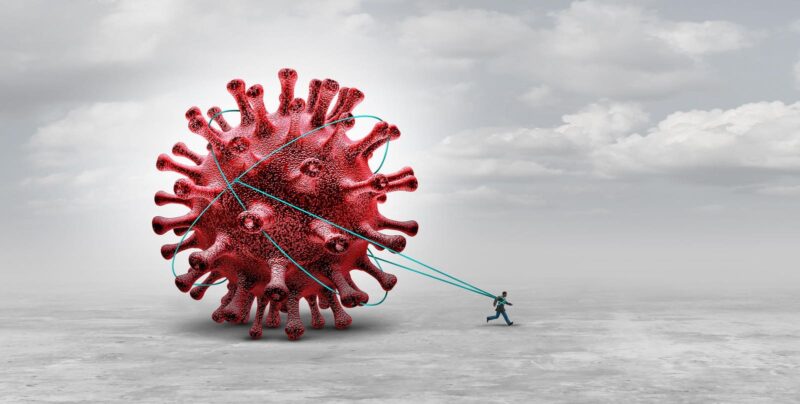Long Covid syndrome
getty
Even as the acute phase of the COVID-19 pandemic fades, the world continues to wrestle with its aftermath — and nowhere is that more evident than in the enduring challenge of Long COVID. The condition, which affects an estimated 7% of U.S. adults, continues to frustrate patients and perplex researchers. Recent studies led by the National Institutes of Health (NIH) have provided a clearer picture yet of how Long COVID manifests and why treating it has proven so difficult. Meanwhile, major pharmaceutical firms are rebalancing their portfolios, cutting back on some mRNA programs while investing heavily in U.S.-based manufacturing to secure supply chains and pivot toward the next phase of innovation.
Long COVID has exposed both the limits of current clinical science and the challenges of pharmaceutical strategy. The condition’s diverse trajectories defy simple solutions; what works for one subgroup may fail in another. Meanwhile, the technology that powered the fastest vaccine rollout in history is being reappraised, with federal agencies retreating from mRNA as the industry doubles down on biologic and vaccine manufacturing.
A Complex, Persistent Burden: The Eight Faces of Long COVID
A new analysis from the NIH’s RECOVER Adult Cohort, published in Nature Communications in November 2025, found that Long COVID is not one condition but a constellation of disease courses — eight, to be exact. The study tracked 3,659 adults for up to 15 months after infection, identifying eight distinct trajectories of symptoms ranging from persistent and severe to mild or improving over time.
Roughly 10% of participants met criteria for Long COVID three months post-infection, and 81% of those still reported symptoms a year later. Five percent experienced a “persistent, high symptom burden” — fatigue, brain fog, and pain that never abated. Another 12% faced “intermittently high” symptoms that came and went, while 14% initially recovered only to see symptoms worsen months later.
“These findings underscore the biological complexity of Long COVID,” said Bruce Levy, senior author of the study and chair of medicine at Brigham and Women’s Hospital. “Understanding these trajectories is essential for designing future treatments and clinical trials.”
A companion report from Mass General Brigham and Brigham and Women’s Hospital, explained some of these findings: women and those hospitalized during their acute infection were more likely to suffer persistent, severe symptoms. The study authors emphasized that the data would help guide resource allocation and research priorities as Long COVID solidifies into a chronic public health burden.
When the Brain Won’t Heal: Cognitive Programs Fall Short
For many, Long COVID’s most disabling symptoms are neurological — memory lapses, fatigue, and “brain fog.” The NIH-backed RECOVER-NEURO trial, published in JAMA Neurology represented the most comprehensive test to date of cognitive rehabilitation approaches. Conducted across 22 sites, the five-arm Phase 2 trial evaluated three interventions: an adaptive online cognitive training program), a structured rehabilitation course, and a home-based brain stimulation therapy.
Despite early promise, the results were disappointing. None of the interventions produced measurable improvements over the control group on the study’s primary endpoint — a modified cognition scale — though participants in all arms reported subjective improvement. The null findings highlight the scale of the challenge: no pharmacological or behavioral therapy has yet shown clear benefit for cognitive Long COVID.
Search For Path Forward
As the science of Long COVID grows more complex, pharmaceutical companies are struggling to find their footing in a rapidly shifting policy and funding landscape. In August 2025, the U.S. Department of Health and Human Services (HHS) announced it would wind down all mRNA vaccine development programs under BARDA, terminating 22 projects worth nearly $500 million. The move, following a review led by Secretary Robert F. Kennedy Jr., marked a decisive shift away from mRNA platforms toward “safer, broader vaccine technologies.” Contracts with universities and companies including Moderna, Pfizer, and Seqirus were canceled or de-scoped.
The retrenchment has had ripple effects across the biotech sector. Moderna, whose fortunes soared during the pandemic, has since terminated multiple clinical programs, including non-COVID mRNA vaccine candidates and a genetic therapy, citing cost-efficiency and strategic reprioritization.
Pivot to Manufacturing and Supply Chain Resilience
Even as R&D spending tightens, the pandemic’s supply shocks have spurred a manufacturing boom in the U.S. biopharmaceutical sector. Industry is investing billions to onshore production and strengthen domestic capacity.
Novartis unveiled plans for a $23 billion, five-year investment in U.S. infrastructure, including a 700,000-square-foot manufacturing hub in North Carolina. The site will integrate biologics, gene therapy, and solid dosage production
Meanwhile, Moderna is investing $140 million in its Norwood, Massachusetts Technology Center, to improve mRNA production and will also support its personalized cancer vaccine platform.
These investments reflect a strategic move that shows global vaccine demand changes and betting on supply chain control and biomanufacturing modernization as competitive advantages.
Vaccine Approval And Research
Despite federal cutbacks, mRNA technology continues to progress. In August 2025, the FDA approved a new COVID-19 vaccine for adults 65 and older and high-risk individuals ages 5–64. The new formulation targets the LP.8.1 sublineage of Omicron, aligning with FDA guidance to match circulating variants. The approval reinforced how mRNA’s flexibility to respond to rapid variant adaptation is critical.
The antiviral Paxlovid, which is being studied as a possible Long COVID therapy. Also, researchers are testing its GLP-1 agonist for Long COVID-related inflammation, while others continue to pursue repurposed or experimental treatments.
Slow, Uneven Recovery
The pandemic’s aftershocks have changed the biotech industry as emergency-era funding ends and and the emergence of chronic post-viral disease as a new therapeutic frontier. Long COVID research now sits at the intersection of public health, neurology, and immunology and the fields demand cross-sector collaboration but offer uncertain returns.
For now, experts note the industry is in transition. Clinical studies reveal the complex, varying, and long-lasting burden of Long COVID symptoms, biopharma companies have to recalibrate their pipelines but simultaneously move forward with investments to strengthen manufacturing and reinforce supply chain resilience.









